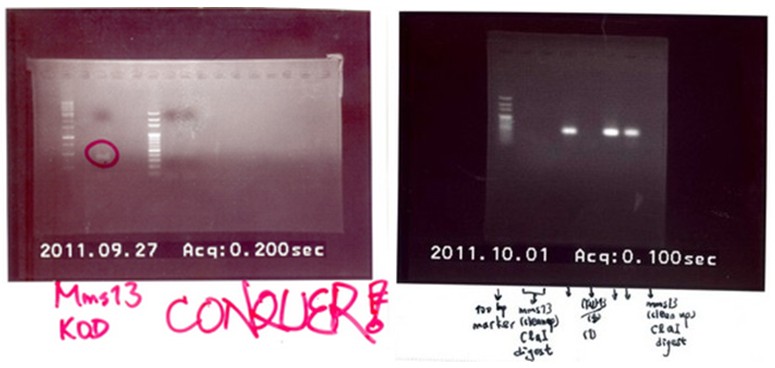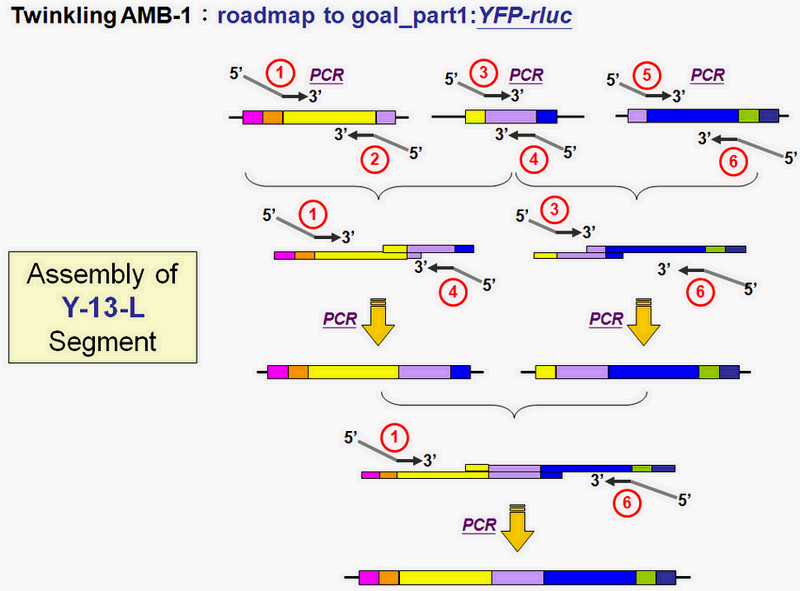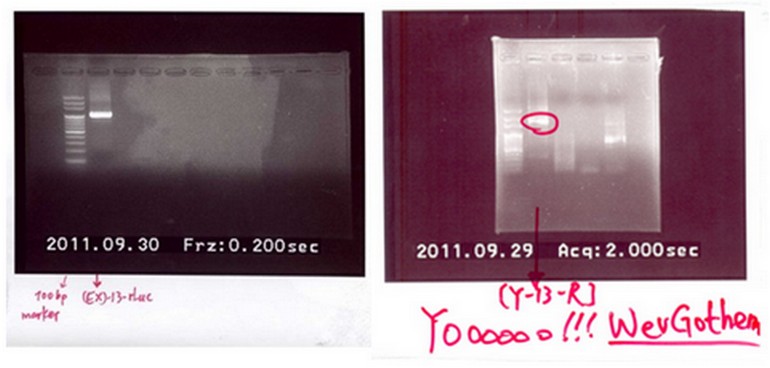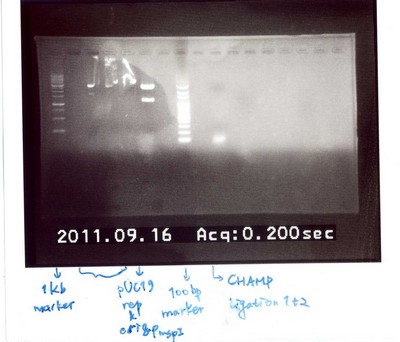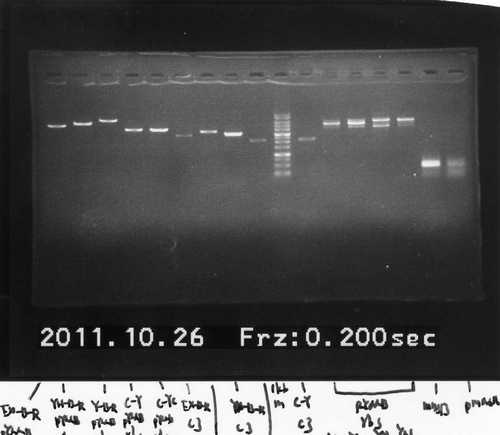Team:NYMU-Taipei/results/optomagnetic-design1
From 2011.igem.org
(→Whole Construct and Experimental Results) |
(→Constructs and Experimental Results) |
||
| (4 intermediate revisions not shown) | |||
| Line 17: | Line 17: | ||
[[Image:total_NYMU.png|frame|center|none|Fig. 1:This is the total constructs of our optomagnetic design, the notation for each columns with different colors can be seen in the following paragraphs.]] | [[Image:total_NYMU.png|frame|center|none|Fig. 1:This is the total constructs of our optomagnetic design, the notation for each columns with different colors can be seen in the following paragraphs.]] | ||
| - | <font size=4><font color=green>The Beginning</font> | + | '''<font size=4><font color=green>The Beginning</font>''' |
| + | |||
As soon as we have the AMB-1 bacterial colony, we do the AMB-1 colony PCR to get the Mms13's DNA sequences as our parts to do the following steps. | As soon as we have the AMB-1 bacterial colony, we do the AMB-1 colony PCR to get the Mms13's DNA sequences as our parts to do the following steps. | ||
| Line 24: | Line 25: | ||
[[Image:13_NYMU.png|frame|center|none|Fig. 2:The correcterized gel electrophoresis result of Mms13.]] | [[Image:13_NYMU.png|frame|center|none|Fig. 2:The correcterized gel electrophoresis result of Mms13.]] | ||
| - | <font size=4><font color=green>Construct Mms13</font> | + | '''<font size=4><font color=green>Construct Mms13</font>''' |
| + | |||
After having the fundamental material of Mms13, we did the next step of our construct(See Figure 3). | After having the fundamental material of Mms13, we did the next step of our construct(See Figure 3). | ||
| Line 34: | Line 36: | ||
For parts <font color=deeppink>mms13-rLuc</font>, links to [http://partsregistry.org/wiki/index.php?title=Part:BBa_K624007 BBa_K624007]; <font color=deeppink>YN-mms13-rLuc</font>, links to [http://partsregistry.org/wiki/index.php?title=Part:BBa_K624008 BBa_K624008]; <font color=deeppink>EYFP-mms13-rLuc fusion</font>, links to [http://partsregistry.org/wiki/index.php?title=Part:BBa_K624006 BBa_K624006]. | For parts <font color=deeppink>mms13-rLuc</font>, links to [http://partsregistry.org/wiki/index.php?title=Part:BBa_K624007 BBa_K624007]; <font color=deeppink>YN-mms13-rLuc</font>, links to [http://partsregistry.org/wiki/index.php?title=Part:BBa_K624008 BBa_K624008]; <font color=deeppink>EYFP-mms13-rLuc fusion</font>, links to [http://partsregistry.org/wiki/index.php?title=Part:BBa_K624006 BBa_K624006]. | ||
| - | + | '''<font size=4><font color=green>Construct CHAMP Design</font>''' | |
| + | |||
As for the CHAMP part, we use ligation process to get the whole sequences of CHAMP peptides. However, we still use the recombinant PCR procedure to anchor either YC or YFP in our process. | As for the CHAMP part, we use ligation process to get the whole sequences of CHAMP peptides. However, we still use the recombinant PCR procedure to anchor either YC or YFP in our process. | ||
Several electrophoresis results for CHAMP constructs are shown below. | Several electrophoresis results for CHAMP constructs are shown below. | ||
| Line 41: | Line 44: | ||
[[Image:champ_NYMU.png|frame|none|Fig. 5:Total <font color=deeppink>CHAMP Ligation</font>, and its part links to [http://partsregistry.org/wiki/index.php?title=Part:BBa_K624010 BBa_K624010].]] | [[Image:champ_NYMU.png|frame|none|Fig. 5:Total <font color=deeppink>CHAMP Ligation</font>, and its part links to [http://partsregistry.org/wiki/index.php?title=Part:BBa_K624010 BBa_K624010].]] | ||
| + | |||
| + | |||
'''<font size=4><font color=green>Whole Construct and Experimental Results</font>''' | '''<font size=4><font color=green>Whole Construct and Experimental Results</font>''' | ||
| Line 73: | Line 78: | ||
[[Image: c7_NYMU.png|frame|none|Fig. 13: Total six constructs after characterization.]] | [[Image: c7_NYMU.png|frame|none|Fig. 13: Total six constructs after characterization.]] | ||
| - | <font size=4><font color=green>Trial and Error</font> | + | '''<font size=4><font color=green>Trial and Error</font>''' |
| + | |||
[[Image: 110.png|frame|none|Fig. 13: The errors we met when trying to ligate 9 divided synthesized sections of Mms13. We solved this problem by using colony PCR to get the gene sequences of Mms13.]] | [[Image: 110.png|frame|none|Fig. 13: The errors we met when trying to ligate 9 divided synthesized sections of Mms13. We solved this problem by using colony PCR to get the gene sequences of Mms13.]] | ||
Latest revision as of 22:33, 28 October 2011

Constructs and Experimental Results
We now follow the steps we construct our design to examine and illustrate what we have done so far. The total parts we constructed and their detailed information are recorded in our partsregistry pages.
The Beginning
As soon as we have the AMB-1 bacterial colony, we do the AMB-1 colony PCR to get the Mms13's DNA sequences as our parts to do the following steps.
The correcterized gel electrophoresis result is shown below.(See Figure 2) The detail of part Mms13's information: [http://partsregistry.org/wiki/index.php?title=Part:BBa_K624005 BBa_K624005].
Construct Mms13
After having the fundamental material of Mms13, we did the next step of our construct(See Figure 3).
The characterized and checked results shown in Figure 4.
For parts mms13-rLuc, links to [http://partsregistry.org/wiki/index.php?title=Part:BBa_K624007 BBa_K624007]; YN-mms13-rLuc, links to [http://partsregistry.org/wiki/index.php?title=Part:BBa_K624008 BBa_K624008]; EYFP-mms13-rLuc fusion, links to [http://partsregistry.org/wiki/index.php?title=Part:BBa_K624006 BBa_K624006].
Construct CHAMP Design
As for the CHAMP part, we use ligation process to get the whole sequences of CHAMP peptides. However, we still use the recombinant PCR procedure to anchor either YC or YFP in our process. Several electrophoresis results for CHAMP constructs are shown below.
Whole Construct and Experimental Results
After we have both materials of Mms13's construction and CHAMP peptides' construction, we use ligation procedure to fulfill six constructs we design in our optomagnetic-design.
The correlated part of construct in Fig. 7 is pYMB essentials+[YN-13-R]+[YC-CHAMP], links to [http://partsregistry.org/wiki/index.php?title=Part:BBa_K624018 BBa_K624018].
The related part of construct in Fig. 8 is pYMB essentials+[YN-13-R], links to [http://partsregistry.org/wiki/index.php?title=Part:BBa_K624024 BBa_K624024].
Part related to construct in Fig. 9 is pYMB essentials+[Y-13-R]+[CHAMP], links to [http://partsregistry.org/wiki/index.php?title=Part:BBa_K624017 BBa_K624017].
Correlated part to construct in Fig. 10 is pYMB essentials+[Y-13-R], links to [http://partsregistry.org/wiki/index.php?title=Part:BBa_K624023 BBa_K624023].

The related part to Fig. 11's construct is pYMB essentials+[13-R]+[Y-CHAMP], links to [http://partsregistry.org/wiki/index.php?title=Part:BBa_K624019 BBa_K624019].
Part related to construct in Fig. 12 is pYMB essentials+[13-R], links to [http://partsregistry.org/wiki/index.php?title=Part:BBa_K624020 BBa_K624020].
Trial and Error
 "
"







